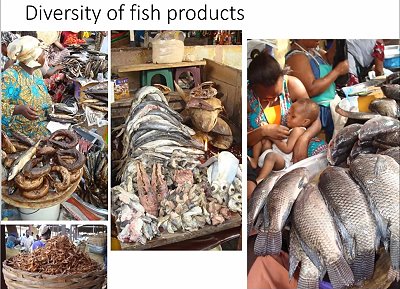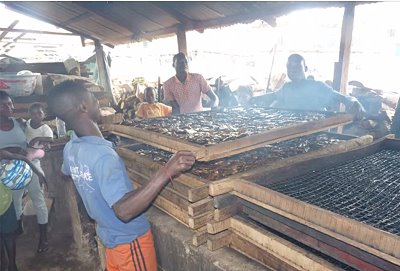Session 2 Processing
 Moderated by Derek Johnson, University of Manitoba, Canada, and team leader of the Dried Fish Matters Project, the speakers were: Ragnhild Overa, University of Bergen, Norway; Benjamin B. Campion, Kwame Nkrumah University of Science and Technology, Ghana; Marian Kjellevold, University of Bergen/Institute of Marine Research; and Lyndon Paul, Danish Care Foods. Co., Ltd. Cambodia.
Moderated by Derek Johnson, University of Manitoba, Canada, and team leader of the Dried Fish Matters Project, the speakers were: Ragnhild Overa, University of Bergen, Norway; Benjamin B. Campion, Kwame Nkrumah University of Science and Technology, Ghana; Marian Kjellevold, University of Bergen/Institute of Marine Research; and Lyndon Paul, Danish Care Foods. Co., Ltd. Cambodia.
Ragnhild Overa started the presentations with a report about reported about field experience in Ghana with processing of small pelagics, both locally caught and imported, as well as tilapia both farmed and wild caught. Quickly deteriorating product quality was a constant challenge for processors and traders. Some chemicals were used to increase shelf life.
She commented on the strong informal institutions supporting smooth transactions. In each community there was an ohemma (queen mother) who oversaw credit relations. Only if her authority was insufficient a council of elders would fine misdemeanour.
She strongly recommended involving trader associations in governance processes with the government and investors. There was significant scope for improving processing and marketing conditions for women in postharvest activities and involving them more directly in the process.
Benjamin Campion listed a history of well-intended attempts to introduce higher performance smoking kilns to the fish processing women in different places. Hardly any modifications to the locally developed models had been accepted.
 A questionnaire administered to processors and traders on the coast and up country showed that cost and speed of smoking were the two dominant choice criteria, while health protection, reduced wood consumption and other proposed innovations did not lead to uptake even in situations where subsidies and accompanying training had been offered. Conclusion: technologies will only work when people demand them.
A questionnaire administered to processors and traders on the coast and up country showed that cost and speed of smoking were the two dominant choice criteria, while health protection, reduced wood consumption and other proposed innovations did not lead to uptake even in situations where subsidies and accompanying training had been offered. Conclusion: technologies will only work when people demand them.
Mariam Kjellevold reported that despite a high per capita fish consumption in Ghana of 25 kg per year, pockets of malnutrition existed. Some food composition analyses had been carried out identifying e.g. nutrient losses during smoking and selected deficits of micronutrients.
The results suggested e.g. that none of the fish species marketed locally were providing sufficient levels of vitamin A by themselves and many of the traditionally smoked fish had high levels of polycyclic aromatic hydrocarbons (PAH) if not peeled before consumption. The sampling gave some pointers to useful follow-up, but did not suggest generally bad nutrition.
Lyndon Paul addressed a different market segment in Cambodia. He pointed out that while the country had the highest per capita fish consumption in the world according to FAO data, the access to that healthy food was skewed. Indeed, it was estimated that 46.8% of women in reproductive age were malnourished and 32.4% stunted. His company had developed a product based on fish powder, beans and other ingredients to complement diets which seemed to help fight malnutrition.
Much of the discussion turned on the difficulty of finding acceptable technical innovations.








